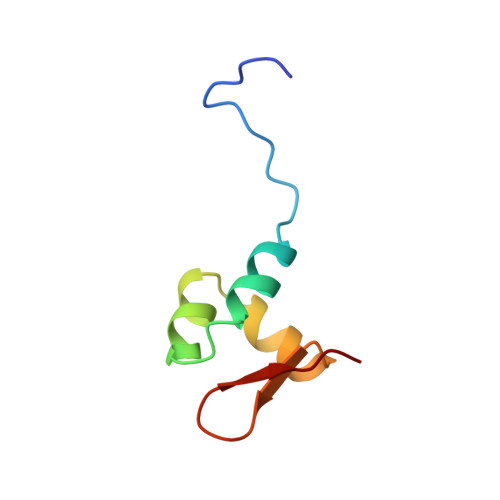The C-terminal domain of HpDprA is a DNA-binding winged helix domain that does not bind double-stranded DNA.
Lisboa, J., Celma, L., Sanchez, D., Marquis, M., Andreani, J., Guerois, R., Ochsenbein, F., Durand, D., Marsin, S., Cuniasse, P., Radicella, J.P., Quevillon-Cheruel, S.(2019) FEBS J 286: 1941-1958
- PubMed: 30771270
- DOI: https://doi.org/10.1111/febs.14788
- Primary Citation of Related Structures:
5MLL, 6GW7 - PubMed Abstract:
DNA-processing protein A, a ubiquitous multidomain DNA-binding protein, plays a crucial role during natural transformation in bacteria. Here, we carried out the structural analysis of DprA from the human pathogen Helicobacter pylori by combining data issued from the 1.8-Å resolution X-ray structure of the Pfam02481 domain dimer (RF), the NMR structure of the carboxy terminal domain (CTD), and the low-resolution structure of the full-length DprA dimer obtained in solution by SAXS. In particular, we sought a molecular function for the CTD, a domain that we show here is essential for transformation in H. pylori. Albeit its structural homology to winged helix DNA-binding motifs, we confirmed that the isolated CTD does not interact with ssDNA nor with dsDNA. The key R52 and K137 residues of RF are crucial for these two interactions. Search for sequences harboring homology to either HpDprA or Rhodopseudomonas palustris DprA CTDs led to the identification of conserved patches in the two CTD. Our structural study revealed the similarity of the structures adopted by these residues in RpDprA CTD and HpDprA CTD. This argues for a conserved, but yet to be defined, CTD function, distinct from DNA binding.
Organizational Affiliation:
Institute for Integrative Biology of the Cell (I2BC), CEA, CNRS, Université Paris-Sud, Gif-sur-Yvette, France.














